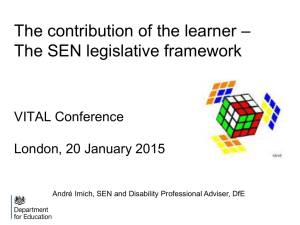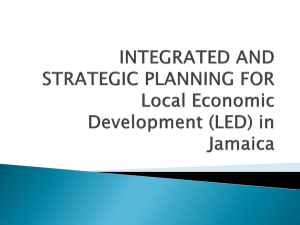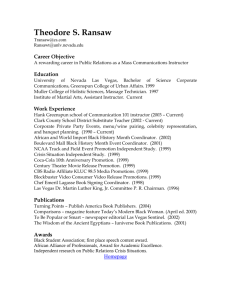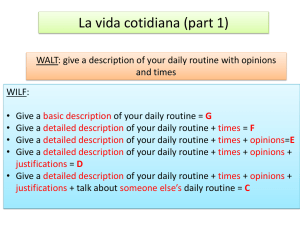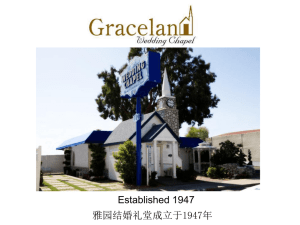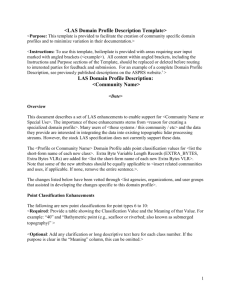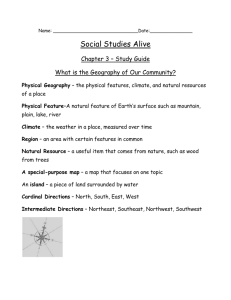Utah State University, Anthropology Ethnographic Field School
advertisement
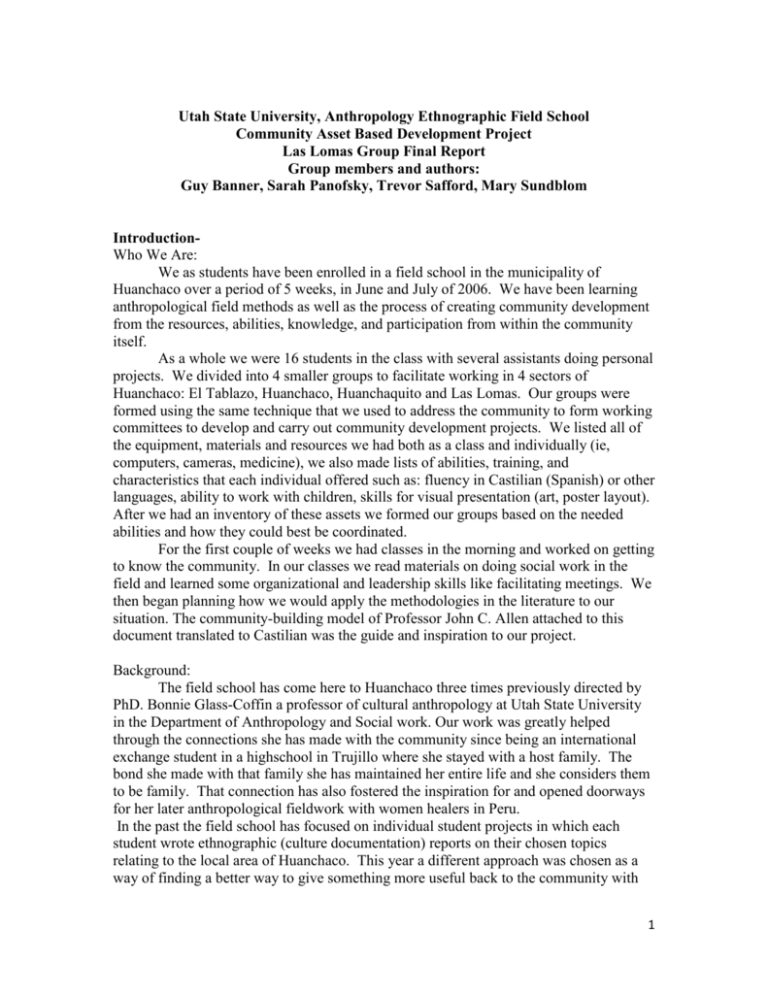
Utah State University, Anthropology Ethnographic Field School Community Asset Based Development Project Las Lomas Group Final Report Group members and authors: Guy Banner, Sarah Panofsky, Trevor Safford, Mary Sundblom IntroductionWho We Are: We as students have been enrolled in a field school in the municipality of Huanchaco over a period of 5 weeks, in June and July of 2006. We have been learning anthropological field methods as well as the process of creating community development from the resources, abilities, knowledge, and participation from within the community itself. As a whole we were 16 students in the class with several assistants doing personal projects. We divided into 4 smaller groups to facilitate working in 4 sectors of Huanchaco: El Tablazo, Huanchaco, Huanchaquito and Las Lomas. Our groups were formed using the same technique that we used to address the community to form working committees to develop and carry out community development projects. We listed all of the equipment, materials and resources we had both as a class and individually (ie, computers, cameras, medicine), we also made lists of abilities, training, and characteristics that each individual offered such as: fluency in Castilian (Spanish) or other languages, ability to work with children, skills for visual presentation (art, poster layout). After we had an inventory of these assets we formed our groups based on the needed abilities and how they could best be coordinated. For the first couple of weeks we had classes in the morning and worked on getting to know the community. In our classes we read materials on doing social work in the field and learned some organizational and leadership skills like facilitating meetings. We then began planning how we would apply the methodologies in the literature to our situation. The community-building model of Professor John C. Allen attached to this document translated to Castilian was the guide and inspiration to our project. Background: The field school has come here to Huanchaco three times previously directed by PhD. Bonnie Glass-Coffin a professor of cultural anthropology at Utah State University in the Department of Anthropology and Social work. Our work was greatly helped through the connections she has made with the community since being an international exchange student in a highschool in Trujillo where she stayed with a host family. The bond she made with that family she has maintained her entire life and she considers them to be family. That connection has also fostered the inspiration for and opened doorways for her later anthropological fieldwork with women healers in Peru. In the past the field school has focused on individual student projects in which each student wrote ethnographic (culture documentation) reports on their chosen topics relating to the local area of Huanchaco. This year a different approach was chosen as a way of finding a better way to give something more useful back to the community with 1 the work of the students. Professor Glass-Coffin, became aware of an emerging model of community development called Asset Based Community Development created and promoted by John C. Allen, Ph.D. from the University of Nebraska-Lincoln, Cooperative Extension in coordination with professionals from other national and regional organizations as well as other universities. Premise: This model differs from other community development in that it approaches development by ascertaining what the assets of the community are. In this context, the word asset is used to describe all of the resources that a community has to offer in all aspects of life, from values and character, to natural resources, human resources, traditional knowledge, institutions like schools, organizations like a Club de Madres or Vaso de Leche (nutritional aid group), as well as businesses. The ultimate goal of this model is to build communities through the discussion of gifts and dreams of members of the community and the building of relationships. In this style of development where at the individual level members of the community are producers and owners of their own development and the benefits that come from it. Community Profile- Mary Sundblom Elevated on the cliffs surrounding the Rio Seco, Las Lomas is demarcated from Huanchaco by a footbridge across the littered gully. Among the unpaved roads lined with brick and cement walls, Las Lomas is scattered with schools, churches, bodegas, internet cafes, panederias, resturants and pharmacies. There is a wide range of houses, from small sloppy brick enclosures with a dilapidated wooden doors to colorful, flawlessly designed, multi-story houses; illustrating wealth differences present in the area. Though most of the houses fit the former description little gardens display individuality. People identify Las Lomas as a tranquil place to live and take pride in working hard and supporting their families. Despite the obvious poverty, Las Lomas possesses a simple charm. Sixteen years ago, inexpensive land enticed a small group of families to move up the hill to what is now Las Lomas. At first the community was small, peaceful, safe, and united even though there was no water, electricity or roads. As the area and population grew in size, the community banded together to bring electricity, lighting, and garbage disposal. Community members came together in a similar fashion, with various evangelicals to install piping and first bring water up the hill from Huanchaco. As numbers increased, wells were constructed for public use but were cemented over and replaced by private wells once their use was exhausted. From the very first time we visited Las Lomas, water and sewage were repeatedly recognized as the primary necessities. Currently, water is only available for one hour a day from the public well at the Plaza de Armas and the people are concerned about water contamination and the possibility of epidemics. Without sewage, deep pits lined with cement are used. However sewage leakage and water contamination is a problem; several people we talked to do not drink the water and buy drinking water in several gallon jugs instead. The Junta Vecinal is the municipality organization that acts as a mayor for Las Lomas and handles the money residents pay for access to the well, garbage collection and 2 security. Community members complain that the Junta doesn’t do anything and are unsure what their funds are really going towards. Frustrated by the apparent lack of results from the Junta Vecinal and the threat of 200 people being displaced by airport expansion, the Frente de Defensa was organized to accomplish what the Junta Vecinal was not. This political divide is the source of much animosity within Las Lomas. With by far the largest project area, to reach all of Las Lomas and understand its complexity. We did make contact with include three schools: Mis Diamantes, a private primary school; Pitagoras, a private primary and secondary school; and the only public primary school in the area. We solicited participation from the heads of the opposing Junta Vecinal and Frente de Defensa and also conversed mother clubs in the community. Although our model for sustainable development projects is based upon assets instead of problems and needs, it is still important to recognize the issues facing Las Lomas. Perhaps our most important assessment of Las Lomas that helped us gain validity in our meetings is the disunity and division present. There is no sense of community and people seem to stay within their familial units, which add to the lack of communication within the community. People recognize and are more that willing to complain about all the problems, but are apathetic in seeking solutions. Generally people feel dependent on the government and outside help for development and lack of education contributes to a lack of consciousness. Other issues identified by the Pitagoras faculty include: the growing disintegration and irresponsibility of the family; lack of security in the community with drug addiction and delinquency as contributing factors; lack of values including respect, love, obedience, and responsibility; lack of personal identity and low self esteem; lack of green areas with a suggestion to increase consciousness for the preservation of the ecosystem; lack of knowledge and compliance of human rights, and the presence of machismo. Despite all this, the past few years produced several community improvement projects. Dutchman, Lars Boch played a key role in creating a large soccer field, a “parque infantile”, and gorgeous garden plaza. A footbridge across the Rio Seco was built in response to El Nino flooding. In response to increased violence, a community watch was formed. The creation of the Plaza Ramón Castillo is an example of how Las Lomas, Huanchaco, and Trujillo joined together to create a positive community space. Even though Las Lomas has issues to overcome, these examples attest to the community’s ability initiate change. Process Transect- Mary Sundblom Rosita Sanchez (full name) led us on our first excursion to Las Lomas. Each group member (Sarah, Guy, Trevor and Mary) assumed different roles according to our individual strengths and skills. As we crossed over the bridge over the Rio Seco and climbed up a dirt hill, Rosita told us about the history of Las Lomas and her life and family there. As we strolled through the town, Rosita pointed out and explained all about the important places and issues in Las Lomas. As chances arose, we stopped in for first contact with some key community members to follow up with later. Our first transect 3 provided an abundance of information and contacts to continue draw on in the continuation of our project. First Focus Group, June 24th- Trevor Safford Throughout the week we invited a myriad individuals from Las Lomas to our first focus group: Martín, Maria Arzola, Zehaida Arzola, Martina Araujo, Luiz, Giovanna, Rene and Carmen. Earlier in the day we assigned roles for each person in our group. Sarah was going to be the facilitator, Bonnie was going to take the place of Guy as scribe, and Mary and I were going to observe, take notes, and help Sarah out with questions. Lawrence and Tamara also accompanied our group in order to view the process and record it visually. Our objective for this meeting was to describe our project and gather community perspective on the process of asset-based community development. Also, we wanted to allocate time for those in attendance to discuss the process with one another. After all, these individuals were the experts. However, even with our meticulous planning, all did not go as anticipated. We began by taking role of all the individuals present. Then Sarah started to facilitate the meeting by introducing our project, “We want to coordinate and create relationships within the community in order to make Las Lomas more sustainable and independent with the least amount of help from outside resources.” Sarah gave a brief account of our past few weeks in Las Lomas, and what we had observed. While Sarah was explaining our perspective, she mentioned the problem of water and sewage. Two women immediately harped in on the subject, and began to describe the problem of contaminated water. Sarah veered them away and continued to guide our focus group towards a more asset-based state of mind. Although these women were willing to talk about the problems in the community, no one was eager to speak about the assets in Las Lomas. Bonnie intervened and asked Sarah to choose someone to speak about his or her individual assets and talents. Due to the rapport we had built with Luis, Sarah picked him to speak. He began by stating that he was a teacher, and said his biggest accomplishment was that all five of his children have or are now attending universities. Then he said he was lucky to have such a large place to live, and that the pharmacy he owns allows him to help the community. Bonnie translated most of the previous information, and at the end told Sarah to ask one of the women to speak. Carmela, and older woman who came to the meeting with her class of students, was chosen, and told everyone that she belongs to a religious group. She brought the kids because she thought it was a religious gathering. However, she was glad she brought them so they could tell their parents about the meeting and our purpose for being in Las Lomas. Also, she stated that the lack of communication in Las Lomas is a significant problem. Everyone lives their own lives and does not speak to one another. She was happy that she happened upon our project, because typically, she would not have known about it. She is in her house most of the day and is secluded from most social interaction within the community. At this point in the meeting, Sarah distributed the surveys and asked the group what they thought of the encuestas. Luis (the pharmacist) commended us on our efforts but was worried about the lack of people in attendance. He had a suggestion- work 4 through the education institutions. He said that when a school holds a meeting, everyone is present. We concluded the meeting with a new objective in mind- to target the educational institutions as a way of reaching the community and promoting awareness of our presence and project. Luis affirmed that he would be our link to these institutions and provide us with a new way of interacting with the inhabitants of Las Lomas. The process of community research was beginning to take form and become tangible not only to us, but to those participating as well. First Meetings with Schools- Mary Sundbom Luis Rodriguez took us out to three different schools, two private and one public school in Las Lomas. Without hesitation, each director invited us in for a brief visit where we explained our project in attempt to solicit help in spreading the word about our project. Each director seemed to be a bit skeptical at first. What won over one of the directors is our assessment of an un-united, private community. She agreed with us and her whole attitude seemed to change for the better. At each of the schools the director wanted to know what our intentions were; if it was just a study or if we were actually going to do something for Las Lomas. Once we assured them we intended to aid in identifying assets within the community and helping to facilitate communication between community members, all were more than willing to help so we arranged meetings in which we could present our project to all the teachers. Public School At the public school, we were able to improvise the meeting that same day, with the three teachers, Carmela Navarro Cerva, Miraya Mendoza Vargas and Juan Armas Palacio. Upon looking at the exterior of the school, the difference between private and public schools was dramatic; the public school obviously had less resources. Where the outsides of the private schools are painted brightly with all kinds of designs, the public school is painted a simple pale blue and hardly identifiable as a school. Noticeably understaffed, with only 4 teachers for 60 kids in 6 different age groups, Miraya got emotional telling us about the difficulty of running a school with such minimal resources where most students families cannot afford school supplies or in some cases lunch. Much of the responsibility falls on the teachers’ shoulders, and they end up assuming roles as cooks, organizers, nurses and caretakers. She also pays for school supplies out of her own pocket. When trying to solicit their help in spreading the word about our project and the big town meeting, they were doubtful that parents would come. Parents always expect to be asked for some contribution and generally they have no such contribution to make. They don’t understand why they should be asked for a few soles for school supplies. Needing an incentive to entice parents to come, we deciced to show a movie for the kids in the morning and send them home to urge their parents to come to a meeting in the afternoon. Pitagoras Pitagoras is a new primary and secondary private school that is trying to adapt their curriculum to the needs and realities of Las Lomas. It is by far the largest and moststaffed, with 17 professors. Met with a much more formal atmosphere and more teachers 5 the mood of our meeting was quite somber. After introducing ourselves, Sarah presented a short explanation of our project and Luis expanded. Inquiry about their thoughts resulted in the typical question: is our intent to conduct a study or actually aid the community in some way? The teachers seemed mostly receptive, some more than others. Just as the meeting was about to end, Luis went off on his own tangent. Unsure of how to handle the situation, our group sat watching for 15 minutes as Luis lectured and drew diagrams on the chalkboard. It was frustrating to feel helpless in stopping this unnecessary attempt of Luis pursuing his own ends. We finally brought the meeting to a close with the teachers willing to share the project with their students and send invitations home with the kids. Mis Diamantes At Mis Diamantes, a private primary school, we caught the tail end of their teachers meeting. Set in a small classroom with bright walls covered in pictures and numbers, the atmosphere of our meeting was open and warm. Including us in their discussion of how ideas of democracy are related to the school and their work environment led nicely into our project presentation to the group of eight teachers. They were enthusiastic and several of the teachers showed an interest in attending a meeting for a core group of organizers and facilitators. Olga Vitvitskaya, the director who demonstrated her skills at facilitating and coordinating, offered to host such a meeting at Mis Diamantes. With the date set, we enlisted Olga along with Elvira Alvaro Arzola and Suli Asecencia to participate in the next meeting. Focus Group at Junta Vecinal, June 29th – Sarah Panofsky In the afternoon of June 29th, we met with Emelio Rodriguez Chavez, the president of the Junta Vecinal. What was supposed to be a tour of Las Lomas quickly turned into an improvised focus group with various community members, associates of the Junta and engineers working on water development projects. Emelio began by introducing us to the various problems facing Las Lomas, its dependence on the municipality, health, water and security. He explained that these are the issues that the Junta is attempting to combat and that they are doing so with a pure heart; they want to see their community develop. Emelio then introduced us to Christian, an engineering student from the University of Trujillo who is helping Emelio with a project concerning water contamination. By focusing on selected neighbourhoods they are attempting to determine the levels of contamination across Las Lomas. Originally Emelio said that there are 8 people on the Junta. He then acknowledged that only two members remained, himself and his secretary, although at least three others seem to be involved at different levels. Another project they are working on is decreasing the cost of electricity. They plan to have the bomba work for 9 hours instead of 13. At this point several other people filed into our meeting. Julio Guetierrez and Roque Rodriguez Barrutia, are engineers from Fundación Femas, which works with the help of international funding on various development projects. Their main focus in Las Lomas is currently on increasing plant biodiversity, which is a challenge due to the dry climate and strong winds from the sea. They are working to transform Las Lomas into an ecological pueblo. Julio said that it is an ambitious project and they would like to 6 incorporate different levels of authority, for example, the mayor and the junta, into the process. When asked about the political conflicts within Las Lomas, especially concerning the Frente de Defensa, Emelio said that he does not like to speak of such things with people from outside because it gives the impression that the pueblo is not united. He said that he likes to work with people of like minds. He said that the Junta is the principle organization of Las Lomas and that all projects should work through them, that the Junta, as opposed to other organizations, like the Frente de Defensa, achieves results. I took this opportunity to introduce our project. Their response was skeptical at first but they were nonetheless enthusiastic and supportive. Emelio said that if we managed to bring a substantial part of the community together at a town meeting it would be more than he has accomplished throughout his entire term. Julio said that our project is a necessary step towards further development; before more large-scale projects can be undertaken, the community must be united. He also wondered how we were planning to moderate the meeting and liked the idea of a group of facilitators who could carry on the process after we leave. Emelio thought that the meeting would be a good opportunity to communicate his projects with his constituents. We closed the meeting on a positive note with an invitation for ceviche the following week. It was an important step to get Emelio and the Junta´s support. Movie and a Meeting July 4th – Trevor Safford On the fourth of July, our group scheduled an activity and a meeting at the public school in Las Lomas. This opportunity was our first chance to give back to the community in a solid and substantial way. The plan was to project a movie for the students, then afterward, have the children inform their parents about a meeting later on that day. Introducing our project, distributing surveys, and establishing rapport with the community were some objectives for the meeting. We, in tandem with the faculty from the school, formulated this plan the day before. Our group could only hope to draw enough individuals in order to generate awareness of our presence and project. The day began with a late start due to a few last-minute arrangements. We arrived in Las Lomas about half past ten o’clock and began to set up the projector. Unfortunately, the room where the movie was going to be displayed was besieged with windows letting in unwanted light. We set out to cover all of the windows with educational posters to garner enough darkness in order to allow the projector to show up on the wall. While Sarah, Guy, and I finished up the final preparations, Jeanne-Marie and Mary played with the children outside. We opened the doors, and the children rushed in with candid excitement on their faces. The movie began and stillness followed. After the children settled themselves, we started serving drinks and snacks to the students, and the rest of the movie proceeded without any significant problems. Once the film finished, Juana, one of the teachers, told the students to go home and ask their parents to come to the school at two o’clock. With our small window of free time, Trevor took pictures and footage of the children during the film to hastily create a small movie of the activity, and the others prepared for the parents to arrive. 7 Parents slowly trickled in. After about twenty arrived (with only one being male), Sarah began the meeting. She described our project, Trevor projected the newly crafted movie, and Guy handed out surveys. Many of the women were illiterate and required aid in completing the encuestas. The faculty and those of us equipped with sufficient Spanish skills helped those who were in need of assistance. As more and more mothers arrived, even Mary and Trevor were engaged in explaining the survey and its purpose with their limited language abilities. Having the teachers help us distribute surveys and assist the illiterate mothers was a terrific way to have community members take a more active role in the process of promoting asset-based community development. At around three o’clock, the number of adults present capped at twenty-six, and most had completed their survey. Sarah asked to play the movie again, and once more the faces of the mothers lit up upon seeing their children playing games and watching the film. Sarah concluded by thanking all of the parents who came and inviting them to the town meeting on Saturday the eighth. Table of Experts Meeting We held our table of local experts meeting with people from the community of Las Lomas on the 5th of July at 4 o’clock pm in the private primary school “Mis Diamantes”. We invited representatives of organizations that we met in our previous meetings as well as the contacts we made while giving out surveys in the streets of las lomas. The attendants included the director of the neighborhood cooperative (alcalde vecinal de la junta vecinal) in Las Lomas Emilio Rodriguez, the gobernador regional Ramon Sanchez, a retired profesor who taught in school in Trujillo and now owns a pharmacy both in Trujillo and Las Lomas, Giovanna the head of a club de madres, Elvira Armas, Estefita Lopez, Geiner Salazar, Elena Panduro, Antonio Sanchez, Julia Asencio, Olga the head of the school, our group as well as Bonnie Glass-Coffin and Lorenzo our technical assistant. In the meeting we began by going around the group having everyone introduce themselves and name a few assets that they had. People spoke more freely afterwards and the was more rapport in the group. Bonnie and Sarah introduced the project and the desired goals and thanked everyone for coming. The amount of political conflict was repeatedly mentioned. Luis suggested a small committee of Las Lomas to form free of political association. Emilio received criticisms for the Junta Vecinal’s ineffectiveness in really getting things done or cooperating with the community. It was emphasized repeatedly that the process will have to start with small groups to avoid political issues and the majority of the beurocracy that occurs in the community development. Town Meeting Preparation With a date set for the Las Lomas town meeting, we had to ensure that the community would actually come. Considering the problems of communication and apathy we knew that we needed a direct and successful publicity approach. In the days leading up to the meeting, Mary and Sarah walked through the streets of Las Lomas filming people to create the video of assets and handing out flyers. This proved to be an 8 effective way of getting the community interested in the project. Everyone wanted to know what these two gringas were doing with a video camera and a stack of flyers. We also put up posters throughout the town, but were disappointed to find many of them torn down the next day. We knew that we needed another way of reaching the far corners of Las Lomas. In the spirit of selling things in Latin America, Carmen put us in touch with fish salesman and we made use of his bicycle/cart equipped with microphone to spread the word. Mary pedaled and Sarah walked beside with microphone in hand, “¡Amigos de Las Lomas, se los invita a una reunion de comunidad!” Mothers came running out of doorways with children in hand and men stood by with broad smiles watching two blond girls make slight fools of themselves. They were a sight to be seen. Town Meeting, July 8 – Sarah Panofsky After a month of preparation we held our town meeting in the Capilla of Las Lomas, in front of the Plaza de Armas on Saturday, July 8th at four in the afternoon. As we struggled to get together all of the computer equipment, raffle prizes, candies, markers and butcher paper, Trevor said that we were optimally unprepared. He repeated it several times as we piled into the taxi and set up in the church. I think he was right. I’m not sure that we had expectations for the meeting; Las Lomas always seems to have surprised us. More than anything we were curious to see how many people would turn out and what their response would be. As three o’clock came around Trevor had just finished the introductory video and slideshow and we finally knew the results of the encuestas. I had my speech written but certainly not memorized and a last minute bail from our tech man put us all a little on edge. Carmen was waiting for us in the Plaza de Armas, ready to run off to the Chicha lady as soon as we arrived. I hoped that Juana, the pincarones lady would come as planned. Despite a few uncertainties I was sure that everything would come together and it did. Carmen blessed the church with incense, Juana got ready outside and slowly people began streaming in. Mary and Guy got started with name-tags and raffle numbers and Bonnie socialized. By the time we began at 4:30 the benches and chairs were full, mostly of women and children and other families stood in the doorway. Guy, Mary, Trevor and I introduced ourselves and welcomed everyone and Carmen said a prayer (mostly to appease the church ladies who weren’t so keen on a group of gringos taking over their capilla). Then we played the movie, “Se les presento la gente de Las Lomas”. The voices of Las Lomas filled the room. “Me llamo Elena, hace cuarto anos que vivo aqui en Las Lomas y tengo muchos habilidades.” It was brilliant, short and touching. Then I began. As I spoke it was hard to gage what kind of response the project was getting. There was some nodding of heads but little other encouragement. We presented the footage of rock painting in El Tablazo and the meeting in Huanchaco. Again it was useful and effective to show actual clips; it kept people interested and entertained. Guy then presented the results of the encuestas. He had placed the information on readable tables in a slideshow presentation. Suddenly we heard a crash, Linda a young lady with epilepsy had fainted. Ironically Guy had just showed the table of the 16 people in Las Lomas who knew first aid. As everyone anxiously crowded around Linda, Bonnie 9 pointed out to me that when Linda heard about the meeting she ran home to bring back popcorn to share with everyone. Bonnie later used her as an example of collaborative community work. After the encuestas Bonnie spoke about our project product. We showed the video again and then raised the idea of forming a committee. After a little persuasion, a lady stood up, Maruga. She spoke of the community work that she was already doing with a group and thought she could further this with an “Agroupación Vecinal”. Then a señor in the front row stood up and said he too would like to take part. No one else volunteered. We then tried to spark a brainstorming of project ideas. For a time no one had any ideas to offer. Bonnie made some serious attempts at inspiring the group into action but her words fell on seemingly deaf ears. John got up and did the same. He asked if this project was going to fail in Las Lomas and everyone shouted ‘no’. People now clearly were in agreement that initiative had to be taken but no one was willing to take the first step. As Rebecca spoke about the Huanchaquito group was accomplishing, Bonnie and I lamented that we hadn’t divided into smaller work groups as we had wanted. Then René told me that a señora in the doorway wanted to teach making rag dolls. He went to get her. The señora ended up being Elena. I took her by the hand and led her to the front of the room. She quickly explained her idea and immediately hands flew up. I began writing names down on the board but soon René took over. He had to struggle to write down everyone who wanted to participate. It was incredible. This seemingly impenetrable crowd was excited. They were contributing. Bonnie asked who supported this group of rag doll makers. A quarter of those present raised their hands. She asked why everyone wasn’t in agreement. They answered they wanted another group, of “tejido” makers. Now everyone was really excited and a list of 15 or so weavers was created. Then Bonnie asked how these groups would be supported, what they would need to function. Maruga stood up and suggested that they hold a food fair. Interestingly, this was the project which was planned. The women in the audience waved their hands frantically, waiting for Bonnie to call on them so that they could offer to contribute a table, a cake, tuna salad, ceviche, chicha morada, mazamoralla, ocopa, diez soles for plates, diez soles for vasos, diez soles for cubiertos, an umbrella, cancha, papa de huancaina… There was so much enthusiasm as everyone excitedly shouted out what they could offer. This was probably the highlight of the meeting. People knew what they had to offer and they brought individual resources and assets together to create something positive for their community. All the while pincarones, popcorn and chicha morada were being served. Not everyone was appreciative as they grabbed for the plates and insisted that they hadn’t received any food when, in fact, they had. I was a little disappointed to see this selfinterest in a meeting centered around community and mutual development. As Bonnie and René expanded the list and plans for the food fair I peeped outside. There was a whole swarm of kids out in the plaza with a slightly overwhelmed Jeannie, Sarah and Emily. Emily ran over to tell me that Jeannie was almost crying and that they had run out of ideas to entertain this bunch of wet, cold and irritable kids. A long line had formed in front of Juana as the children waited for their pincarones. James stood near the front marking hands with a blue pen. The kids seemed to have found a way around this minor obstacle though and they licked their hands and then returned to the line. Emily, holding 10 a sleeping baby in her arms, asked when the meeting would be over. Inside was only slightly less chaotic, but Bonnie was keen to end the meeting with a plan and we did a short while later. The food fair is to be held Thursday, the 13th at three in the afternoon in the plaza. We invited everyone to our closing fiesta and planned for a meeting to discuss future projects on Monday, the 10th, at six, at the Junta Vecinal. We showed a slideshow of pictures to an uplifting marinera and ended with a “Vive Las Lomas!” We hurried the crowd out the door as the ladies rushed to clean the capilla for mass the next day. As we packed up we were approached again and again by people thanking us and kissing us goodbye. I realized that we had forgotten to raffle off the food bags. John jumped in and said it had to be done. He raffled off four of them in the plaza. Many complained that they didn’t have a number on their name tag, some didn’t have a name tag at all. I apologized but it was out of our hands. The line for the pincarones had still not yet receded. After a time we finally said “No hay más pincarones”. It was dark and we were all tired. I thanked Giovanna, Magaly, Carmen and René and we walked back down to Huanchaco feeling tired but content. The meeting was a success. The outcome was a surprise perhaps but it was a success nonetheless. A substantial crowd had come and made plans for some community groups and events. Interesting many of those contacts we made in the past month did not come, significantly, those from opposing political groups were not present. I think the new faces were a positive change though; we managed to share our project with a significant number of community members, convince them of the assets Las Lomas has and entertained fifty or so children for the afternoon. Next Steps- Sarah Panofsky John Allen’s model assumes that the community will take over the process of change, using their resources and assets to further their own development. At first we were not sure if this was going to happen in Las Lomas. The area was too big and opposing political groups had left the people jaded with little impetus to initiate change. We began writing this final report not knowing if we would have a group of people to give it to. Our optimism was renewed though with a meeting on Monday, July 10th. We arrived late to find five women and one man waiting outside the Junta Vecinal. No one had asked for use of the building and so it was locked but Maruga, who had been an important contributor at the town meeting, told us that she knew of a good location nearby. We followed her into a darkened room, in a house beside the church. As we sat down, Guy, Mary, Trevor and I were all dubious of whether a meeting would be possible in blackness but soon a little girl came in with candles. The room is a small literacy center where Maruga teaches adults such as the doña and dueño to read and write. It seemed appropriate that our meeting be held there with its dirt floors and walls decorated by bright letters and simple phrases. The group had everything organized. They were equipped even with their own butcher paper and markers. Maruga had the lists taken at the town meeting and everyone took their own notes. As those present introduced themselves we were surprised to learn this seemingly cohesive group had not met before. They spoke their objectives, for the meeting at hand and the future. For that night they chose to focus on planning the food fair for the coming Thursday. 11 Maria Elena was somewhat apologetic when speaking about the general goals for the group. She was sorry that a larger committee had not formed to officially carry out asset-based development. She said that they were only a few dedicated neighbors who would plan a food fair and than a tejido cooperative of sorts. I stopped her here saying that this was exactly what the project intended; small groups using what assets and resources they had to create feasible projects for their community. (names) were taking the first real community step after five weeks of our pushing the project and trying to convince people of its use. It was so gratifying to sit back and watch this group of capable people organize all the details for the fair. They got off topic twice, but someone always brought the conversation back to the task at hand. They figured out what materials would be necessary and who would bring them, the time, date and place, who everyone was who had promised to contribute, music, publicity, and even the prices of dishes. I couldn’t help but smile all the while. There was no politicking, no raised voices, only some pleasant joking and much organizing. With the food fair planned, conversation shifted to a name and slogan. Elena suggested “Nuevo Amanecer”, a New Sunrise. While more plans were made for a meeting on Thursday afternoon to count the money and a follow up meeting on Saturday, Trevor drew a graphic of the Las Lomas capilla and a bright sun rising behind it. They completely loved it. We offered to make cookies for the fair and to come up early on Thursday to help set up. What a shame it was that we did not meet these dedicated individuals earlier in our process. Regardless, we will leave confident that people in Las Lomas will carry on. A tejido cooperative will bring together the talents of so many women and from that basis other projects can be planned and expanded. Conclusion Adapting John Allen’s process of asset-based community development has been a road filled not only with difficulty and doubt, but also possibility and a hope for a new beginning. At the outset, time was against us. We were given a procedure that was originally formulated to carry on for about six months to a year, and our group was granted a brief five weeks to bring about beneficial social change in a community who was initially unaware of our presence and unwilling to amend its ways. Furthermore, according to John Allen, before one can attempt asset-based development, the community must have the desire for change. The inhabitants of Las Lomas were conscious of the problems enveloping the community, but did not possess the drive to try and solve them. Lastly, the size of Las Lomas, rivaling that of Huanchaco, was a daunting location to be assigned to four inexperienced undergraduates. Simply put, the odds were against us. However, now, after having a town meeting and observing the first committee gathering planned and conducted by members of the community, we have overcome these odds and fulfilled our role as the catalyst to spark asset-based community awareness and development. Watching this process unfold has been an invaluable and unforgettable experience. Being given John Allen’s process was like being presented with a deck of cards and charged with building a pyramid out of those cards. As we met our first contacts in 12 the community, we slowly built our first level, aligning each card with care. We held our first focus group, and slid more cards into place to solidify our base. With more and more relationships formed, the pyramid grew larger and larger, level by level, link after link. In order for the pyramid’s integrity to remain intact, the individuals in the community had to lean on one another for strength and support. After the town meeting, we removed our hands from each side of the pyramid allowing it to finally stand on its own. Now, although still delicate and unfinished, the construction of the pyramid now lies in the hands of the community, and as they keep building rapport with one another, the strength and size of the pyramid will continue to grow. Appendix Committee Contact List: This list includes the names and addresses and/or phone numbers of members of the community committee initiated by this project at the time of the end of our course. More people will be included in time as the committee and those who want to be involved in the project are added into the roster. The name of the committee is Nuevo Amanecer (New Dawn). 1. Maruja Aurora Ramos Vargas Mz. 9, Lot. 5 Las Lomas –Hco. 2. Maria Elena Bonites Botadelli Mz. 30, Lot. 6 Las Lomas –Hco. – Telefono: 462030 3. Margarita Huaman Mz. 1, Lot. 2 Las Lomas – Hco. – Telefono: 584133 4. Elena Panduro de Culqui Mz. 35, Lot. 12 Las Lomas –Hco. 5. Jose Luis Guevara Barreno Mz. 10, Lot. 10 Las Lomas –Hco. -Telefono: 461753 Contacts: Fernando Perez - Presidente de CIADES NGO Carmen Diaz Rene Gonzalez Giovanna Arroyo Diaz- Presidenta de una Club de Madres Rosa Sanchez Luiz Rodriguez Martin Delgada Olga Vitvitskaya Suli Ascencio Elvira Alveredo Arsola Emelio Rodriguez Chavez Elena Panduro de Culqui School Contacts: Pitagoras 13 Mis Diamantes Escuela Primaria Estatal de Las Lomas (public school) Committee List: Maruja Aurora Ramos Vargas Maria Elena Bonites Botadelli Margarita Huaman Elena Panduro de Culqui Jose Luis Guevara Barreno Sarah’s Speech Somos estudiantes de la Universidad Estatal de Utah y hace un mes que estamos aquí, viviendo en Huanchaco, haciendo una programma de anthropologia. Somos 16 estudiantes y trabajamos en cuatro grupos aquí en Las Lomas, Huanchaco, Huanchaquito y El Tablazo. Intentamos hacer un proyecto de desarrollo comunitario sostenible basado en los ideas de John Allen, un Americano que ha trabajado sobre un tipo de desarrollo basado no en las necesidades de una comunidad pero en sus ventajas locales. No tenemos recursos financias, tenemos solamente nuestro entusiasmo, la habilidad de ver la realidad de Las Lomas desde afuera y un idea de un proyecto que tiene la capacidad de desarrollar esta puebla. En un mes hemos visto que Las Lomas es una buena comunidad. Los personas de aca son muy trabajadores y quieren mejorar la vida de sus hijos. La comunidad tiene buenas escuelas, hay bastantes negocios; farmacias, bodegas, pananderias y peluquerias, tiene cafes de internet, hay plazas y parques, electricidad y luz, hay una buena clima, es un sitio tranquillo y es muy cerca del mar y de Trujillo. Es una comunidad tambien con bastante recursos humanos, de los cuales hablare despues. Aunque esta comunidad tiene bastante fortalezas no esté unida. No hay comunicación entre la gente. Familias se quedan independientes; no se preocupan por sus vecinos y esta comunidad esta bastante dividido por conflictos politicos. Pero esta falta de comunicación, estos conflictos impide el desarrollo de Las Lomas. Para hoy dejamos la politica, y nos concentramos en esta reunion para tratar de los bienes, dones y habilidades que tenemos todos. En semanas recientes hemos conocido cuales son estos habilidades y ventajas de los habitantes de Las Lomas por encuestas que hicieron 50 de sus vecinos y amigos. Tuvimos reuniones con algunos de ustedes, con los profesores, estudiantes y lideres de la comunidad. Intentemos a incentivar que la gente aqui se den cuenta de todos los bienes que tiene. Centrarse en problemas de la comunidad transporta imagines negativas de la comunidad y los residentes aceptan estas imagines como la realidad. De l’otro lado, centrarse en componentes positivos da a los residentes esperanza y una vision positiva de si mismos. Con esta esperanza se puede conectar las ventajas que posee una comunidad y sus capacidades pueden ser fortalecidas. En la historia de Las Lomas, los residentes se han reunido para desarrollar sus propios proyectos. Se han formado comites de vigilancia, han trabajado juntos para obtener la electricidad y la luz y los primeros tubos para llevar agua de Huanchaco. Pero 14 ahora, lamentablemente parece que hayan dejado este actitud revolutionaria mientras que deben de seguir actuando. Sin accion, sin iniciativa no habra progreso. Quiero ahora compartir con ustedes lo que este proyecto logro en Huanchaco, El Tablazo y Huanchaquito. Aquí tenemos un pequeño video para mostrarles. Claro este idea de desarrollar una comunidad en una manera sostenible desde abajo hacia arriba, con los recursos que ya tiene la comunidad es posible. Desde proyectos pequenos, la gente se reuniara, enlaces seran creados. Ahora quiero mostrarles las resultas de las encuestas. Estas encuestas representan solamente un porciento de la población de Las Lomas y demuestra el potencial de este pueblo! Si solamente un porciento de la población tiene tantas habilidades, imaginanse los proyectos que podrian ser creados con las habilidades de todos en Las Lomas. Han visto las habilidades, los bienes y dones que tiene la gente de esta comunidad. Quienes de ustedes tienen ideas de proyectos. Que ayuda de sus vecinos necesitara para realizar estos proyectos? Como podriamos usar este plan de desarrollo sostenible en Las Lomas? El senor Rene Gonzalez, su vecino de Las Lomas va a tratar de dirigir las innervaciones, los ideas Han visto las habilidades, los bienes y dones que tiene la gente de esta comunidad. Quienes de ustedes tienen ideas de proyectos. Que ayuda de sus vecinos necesitara para realizar estos proyectos? Como podriamos usar este plan de desarrollo sostenible en Las Lomas? El senor Rene Gonzalez, su vecino de Las Lomas va a tratar de dirigir las innervaciones, los ideas. 15
